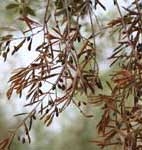Elizabeth Fichtner1, Dani Lightle2, Dan Flynn3, Rodrigo Krugner4
UC Cooperative Extension (UCCE) Tulare1, Kings1, Glenn2, Tehama2, and Butte2 Counties, UC Davis Olive Center3, USDA, Agricultural Research Service, San Joaquin Valley Agricultural Sciences Center4
The recent outbreak of the plant bacterium Xylella fastidiosa in southern Italy illustrates the potential for introduced organisms to incite widespread havoc in a short time. Xylella fastidiosa has been found in association with a new disease called olive quick decline syndrome (OQDS), which is affecting over 20,000 acres of olive in the Apulia region of Italy. Symptoms of OQDS include extensive branch and twig dieback, yellow and brown lesions on leaf tips and margins, vascular discoloration, and subsequent tree mortality. In southern Italy, the main insect vector of X. fastidiosa is the spittlebug Philaenus spumarius, which is known to occur in California. While research is underway to determine if the bacterium is responsible for causing OQDS, establishment of X. fastidiosa in Europe leaves growers and researchers asking where it came from. Genetic techniques used to compare pathogen populations have led researchers to hypothesize that the isolates of X. fastidiosa (strain CoDiRO) associated with OQDS, may have originated in Costa Rica. Marking the first European find of X. fastidiosa outside of Italy, the bacterium also was found on ornamental coffee plants at a retail market near Paris in April 2015; the plants had been imported to Europe from Honduras (3). In July 2015, X. fastidiosa was identified on ornamental plants on the French island of Corsica and on the mainland in October 2015 (2). The X. fastidiosa subspecies found in Corsica (subspecies multiplex) is different from that associated with OQDS in Italy (subspecies pauca) (2).
The European Commission has imposed several regulatory actions to prevent further spread and introduction of X. fastidiosa into the European Union, including a specific ban on import of coffee plants from Honduras and Costa Rica; eradication measures in Italy and France; and the potential for strict eradication measures aimed at new outbreaks or finds of the bacterium, including removal and destruction of infected plants, and all host plants within a radius of 100 m. (1)
The new introductions of X. fastidiosa to Europe illustrate the potential for long distance dispersal of the bacterium and a vulnerability of California agriculture to invasion by new organisms. The United States Department of Agriculture-Animal and Plant Health Inspection Service-Plant Protection and Quarantine's (USDA-APHIS-PPQ) New Pest Advisory Group (NPAG) is assessing the biology and potential economic and environmental impacts that the strain CoDiRO may pose to the United States to recommend potential regulatory strategies (Tara Holz, personal communication). NPAG is designed to inform Federal decision makers regarding potential regulatory actions that may be appropriate to prevent pest introduction.Previous USDA-led research has found X. fastidiosa in California olive trees, but the endemic bacterium has only limited association with disease and is a different subspecies than the CoRiDO strain associated with the OQDS in Italy.
California olive growers and industry stakeholders are encouraged to contact UCCE Farm Advisors to report trees displaying symptoms of OQDS.
References
1. European Commission Press Release, April 28, 2015: http://europa.eu/rapid/press-release_IP-15-4887_en.htm
2. European and Mediterranean Plant Protection Organization. 2015. First reports of Xylella fastidiosa in EPPO region-Special Alert. http://www.eppo.int/QUARANTINE/special_topics/Xylella_fastidiosa/Xylella_fastidiosa.htm
3. French Ministry of Agriculture Food and Safety Press Release, April 29, 2015: http://translate.google.com/translate?hl=en&sl=fr&tl=en&u=http%3A%2F%2Fagriculture.gouv.fr%2Fstephane-le-foll-salue-la-mise-en-place-de-mesures-europeennes-de-prevention-contre-la-bacterie-xylella
Attached Images:
